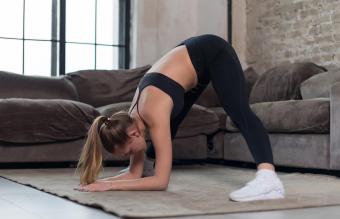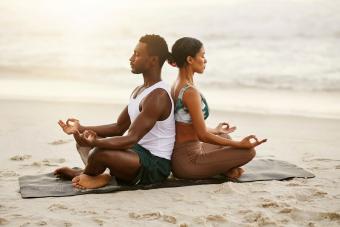
There are many Iyengar yoga positions for beginners to try, because one of the fundamental aspects of this style is to use yoga equipment and props to help learn form and avoid injury.
What Is Iyengar Yoga?
The Iyengar style of Hatha Yoga is one of the most accessible and popular yoga methods in the world. Founded by B.K.S. Iyengar, this method demystifies yoga asanas for beginners by using props such as wooden blocks, straps, and bolsters. This enables individuals at all levels of fitness to begin practicing and understanding yoga. Iyengar's philosophy is once a practitioner becomes fluid in form, this will lead to the pursuit of the broader concepts of yoga, especially the eight yoga sutras.
Another important element of Iyengar Yoga is the practice of pranayama, or yogic breathing. Practitioners believe the concentration of breath combined with a focus on proper pose alignment frees the spirit and mind.
Many consider Iyengar to be one of the preeminent yoga gurus. His book, Light on Yoga: The Bible of Modern Yoga, is a foundational learning text for serious yogis and instructors. There are instructors of the Iyengar method in more than 40 countries, as well as four institutes of charitable work and instruction.
Famed instructors Rodney Yee, Patrica Walden, Gabriella Giubilaro and Michelle LeRue are just few devotees of the Iyengar method.
Popular Iyengar Yoga Positions for Beginners
As with all styles, it's always best to try Iyengar yoga positions for beginners under the guidance of a certified instructor. He or she will be a font of information regarding the history of the posture, gradual modifications that help you get into full pose, and tips to prevent injury.
Here is a small sample of Iyengar yoga positions beginners may find easy. For pictures of the following poses, visit the B.K.S. Iyengar site.
- Paschimottasana (Sitting Forward Bend): This helps you stretch the hamstrings and the back. Never force the stretch - use pillows or bolsters to ease into the posture. As you build flexibility and knowledge of the posture, you'll use the props less.
- Adho Mukha Virasana (Downward Facing Hero Pose): You can move easily into this posture from Hero Pose. Many people find it more comfortable to straddle a long cushion or bolster and lie on additional pillows to reduce strain on tight thigh and back muscles.
- Tadasana Variations (Mountain Pose): One of the easiest Iyengar yoga positions for beginners, this posture features arm variations to help extend breath and center the mind and body. Some people use a strap to complete arm positioning.
- Uttanasana (Standing Forward Bend): A terrific posture for hamstring release and to clear the mind. If you look closely at this posture on the Iyengar site, you'll notice the model is using four yoga blocks to complete the pose! This is just one example of how props can help.
- Supta Baddha Konasana (Reclining Bound Ankle Pose): This pose helps to temper blood pressure, open the hips and groins, and relieve menstrual pain. You'll use several bolsters or folded blankets behind you, as well as blocks under your knees.
- Savasana (Corpse Pose): This reclining posture doesn't always need props, but some people are more comfortable resting on a bolster with a pillow under the head. Take your time with this one - it's extremely relaxing.
Helpful Resources
Again, it's much easier to learn the Iyengar method from a certified instructor. However, reviewing these DVDs may help get you started.
- Yoga Journal Presents: Iyengar Intensive at Estes Park DVD Set features Iyengar's teachings at a Yoga Journal conference, and full classes of yoga and pranayama.
- A.M. and P.M. Yoga with Rodney Yee and Patricia Walden is a great introductory DVD to the Iyengar style and for absolute beginners. The gentle instruction provided by Yee and Walden demonstrates just how easy it is to start a dedicated yoga practice.
- Iyengar Yoga with Gabriella Giubilaro isn't for the beginner, actually. However, it is a wonderful demonstration of what you may be able to accomplish in a few months with regular practice.







